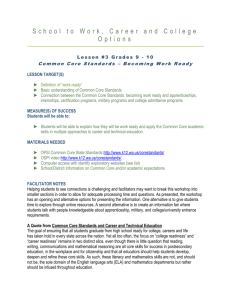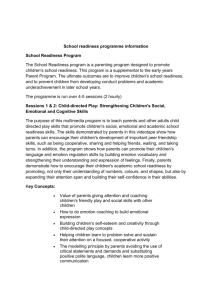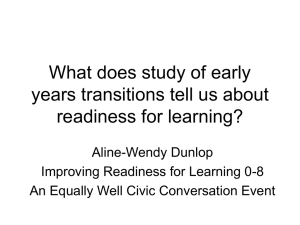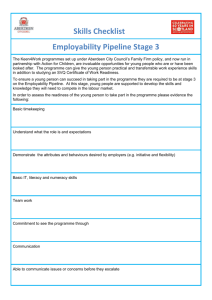A Common Core of Readiness
advertisement
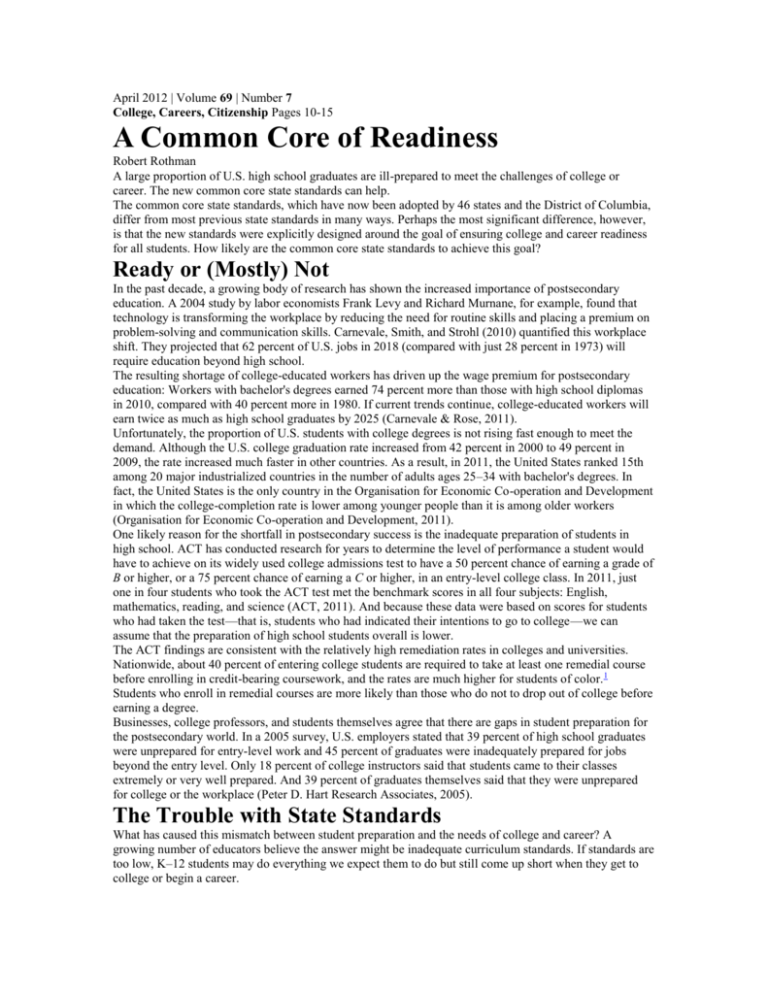
April 2012 | Volume 69 | Number 7 College, Careers, Citizenship Pages 10-15 A Common Core of Readiness Robert Rothman A large proportion of U.S. high school graduates are ill-prepared to meet the challenges of college or career. The new common core state standards can help. The common core state standards, which have now been adopted by 46 states and the District of Columbia, differ from most previous state standards in many ways. Perhaps the most significant difference, however, is that the new standards were explicitly designed around the goal of ensuring college and career readiness for all students. How likely are the common core state standards to achieve this goal? Ready or (Mostly) Not In the past decade, a growing body of research has shown the increased importance of postsecondary education. A 2004 study by labor economists Frank Levy and Richard Murnane, for example, found that technology is transforming the workplace by reducing the need for routine skills and placing a premium on problem-solving and communication skills. Carnevale, Smith, and Strohl (2010) quantified this workplace shift. They projected that 62 percent of U.S. jobs in 2018 (compared with just 28 percent in 1973) will require education beyond high school. The resulting shortage of college-educated workers has driven up the wage premium for postsecondary education: Workers with bachelor's degrees earned 74 percent more than those with high school diplomas in 2010, compared with 40 percent more in 1980. If current trends continue, college-educated workers will earn twice as much as high school graduates by 2025 (Carnevale & Rose, 2011). Unfortunately, the proportion of U.S. students with college degrees is not rising fast enough to meet the demand. Although the U.S. college graduation rate increased from 42 percent in 2000 to 49 percent in 2009, the rate increased much faster in other countries. As a result, in 2011, the United States ranked 15th among 20 major industrialized countries in the number of adults ages 25–34 with bachelor's degrees. In fact, the United States is the only country in the Organisation for Economic Co-operation and Development in which the college-completion rate is lower among younger people than it is among older workers (Organisation for Economic Co-operation and Development, 2011). One likely reason for the shortfall in postsecondary success is the inadequate preparation of students in high school. ACT has conducted research for years to determine the level of performance a student would have to achieve on its widely used college admissions test to have a 50 percent chance of earning a grade of B or higher, or a 75 percent chance of earning a C or higher, in an entry-level college class. In 2011, just one in four students who took the ACT test met the benchmark scores in all four subjects: English, mathematics, reading, and science (ACT, 2011). And because these data were based on scores for students who had taken the test—that is, students who had indicated their intentions to go to college—we can assume that the preparation of high school students overall is lower. The ACT findings are consistent with the relatively high remediation rates in colleges and universities. Nationwide, about 40 percent of entering college students are required to take at least one remedial course before enrolling in credit-bearing coursework, and the rates are much higher for students of color. 1 Students who enroll in remedial courses are more likely than those who do not to drop out of college before earning a degree. Businesses, college professors, and students themselves agree that there are gaps in student preparation for the postsecondary world. In a 2005 survey, U.S. employers stated that 39 percent of high school graduates were unprepared for entry-level work and 45 percent of graduates were inadequately prepared for jobs beyond the entry level. Only 18 percent of college instructors said that students came to their classes extremely or very well prepared. And 39 percent of graduates themselves said that they were unprepared for college or the workplace (Peter D. Hart Research Associates, 2005). The Trouble with State Standards What has caused this mismatch between student preparation and the needs of college and career? A growing number of educators believe the answer might be inadequate curriculum standards. If standards are too low, K–12 students may do everything we expect them to do but still come up short when they get to college or begin a career. Standards-based reform has been the de facto national education reform strategy for more than two decades. Spurred by federal legislation, states have placed standards—statements of the content and skills all students should learn—at the center of their improvement efforts. By the end of the 1990s, all states had adopted standards for student learning, assessments aligned to the standards, and accountability systems that measured school performance on the basis of student attainment of the standards. But gradually, educators and policymakers have realized that many state standards were set too low and that these standards varied widely from state to state. A 2008 study conducted by researchers at the University of Pennsylvania compared state content standards in mathematics and found very little commonality among the states (National Research Council, 2008). The most glaring evidence of the variation in state standards came from the results of the National Assessment of Educational Progress (NAEP). No Child Left Behind requires every state to administer the NAEP in reading and mathematics every two years, and the data appear to show some wide differences between NAEP results and the results on state tests. For example, in 2005, 87 percent of 4th graders in Tennessee were proficient on the state test in mathematics, but only 28 percent were proficient on the NAEP. In contrast, in Massachusetts, 40 percent of 4th graders were proficient on the state test in mathematics and almost the same proportion (41 percent) were proficient on the NAEP. These discrepancies have raised concerns that some states' standards set expectations below what students need to succeed in college and careers. New Standards Focused on Readiness Faced with such data, state leaders in 2006 began to consider developing standards that would be common among states, not only to reduce variability but also to ensure that the expectations matched the requirements of postsecondary education. The Council of Chief State School Officers and the National Governors Association led the effort, which became known as the Common Core State Standards Initiative (CCSS). The project, launched in April 2009, was divided into two parts. First, teams would develop anchor standards for college and career readiness in English language arts and mathematics, which would indicate the knowledge and skills students needed at the end of high school. Then a separate team would design grade-by-grade standards in those two subjects that would lead students to the anchor standards. The final set of standards was released in June 2010. From the outset, CCSS leaders designed the effort to differ from the process most states had used to set their standards. Many state standards were developed by teams of educators and community members, using a variety of criteria. In many cases, the process involved logrolling to gain political support; the result was a long list of standards that might or might not have anything to do with college and career readiness. CCSS leaders, in contrast, established clear criteria for the standards; one of the most important was that the standards reflect research on college and career readiness. Topics that might be interesting but that were not essential for postsecondary success would be thrown out. The research did not have to be ironclad; it just had to represent the best available knowledge. This criterion guided the standards writers' work and minimized some of the ideological battles that had plagued standards setting in the past. In addition, the CCSS leaders asked representatives from Achieve, ACT, and the College Board to craft the anchor standards. These organizations had considerable expertise in the area of college and career readiness, and they could enlist business and higher education partners to verify their judgments about what might be necessary for employment or postsecondary education. In developing the college and career readiness standards, the standards writers defined readiness as the ability to succeed in entry-level, credit-bearing, academic college courses and in workforce training programs. That is, students who met the standards should be able to enroll in postsecondary education without needing remediation. For college, that meant enrolling in either a two-year or four-year institution; for workforce training, it meant enrolling in programs that prepare students for careers that offer competitive, livable salaries and opportunities for career advancement in a growing or sustainable industry. To develop the standards for college and career readiness, the standards writers started with evidence from postsecondary education and the workplace. They also conducted their own research by buying introductory college textbooks and studying the kinds of reading and mathematics that students would be expected to do in their first year of college. And they asked teachers of first-year college courses to confirm their judgments about what students should know and be able to do. What's New in the New Standards? Will the common core state standards succeed in their ultimate aim of improving the college and career readiness of U.S. students? We won't have the definitive answer to that question until states have implemented the standards and collected evidence to determine whether students who meet them can function successfully in postsecondary education and in the workplace. Preliminary reviews indicate, however, that the standards at least reflect the expectations of colleges. For example, in a survey by the Education Policy Improvement Center (EPIC) at the University of Oregon, professors of first-year college courses agreed that the standards reflect the knowledge and skills students need to have in their courses (Conley, Drummond, deGonzalez, Rooseboom, & Stout, 2011a). And a separate EPIC study found that the standards match well with the expectations students encounter in such highly regarded programs as the International Baccalaureate (Conley et al., 2011b). In the end, the standards define some clear expectations for what students should know and be able to do. And these expectations are more closely aligned in several important ways with what students need to succeed in college and careers. Reading. In reading, the standards place a heavy emphasis on the ability to comprehend complex texts. This emphasis stems from research that shows that students who can comprehend complex texts are more likely to be successful after high school (ACT, 2006). Many students currently lack this ability. The complexity of workplace materials and college textbooks have held steady or increased over the past 50 years (Council of Chief State School Officers & National Governors Association Center on Best Practices, 2010); meanwhile, the level of text complexity in high schools has actually declined over time (Chall, Conard, & Harris, 1977; Hayes, Wolfer, & Wolfe, 1996). And in many high schools, teachers often don't even require students to read or comprehend these easier texts. Instead, many teachers attempt to make comprehension simpler for students by presenting material via PowerPoint or reading aloud. Writing. In writing, the common core state standards reflect college and career readiness by reducing the traditional emphasis on narrative writing and placing a greater emphasis on informational and explanatory writing. Personal narratives are a staple of schooling ("How I Spent My Summer Vacation"), but except for college application essays, students will seldom be required to write personal narratives in college or the workplace. Informational writing, in which the author attempts to explain something or to inform others about a topic, is a much more important skill in these settings. Mathematics. The high school mathematics standards are intended for all students and represent the threshold level necessary for college and career readiness. In fact, as the standards document notes, research on college and career readiness suggests that much of the mathematics necessary for postsecondary success is taught in grades 6–8. This includes applying ratio reasoning in solving problems; computing fluently with fractions and decimals; and solving problems involving angle measure, surface area, and volume. However, the standards also include content that students would need to know if they pursue higher-level mathematics, such as calculus, discrete mathematics, or advanced statistics. This content is designated with a special symbol (+). Next Steps Even the most fervent advocate of the common core state standards would acknowledge that the standards themselves will not ensure that students graduate from high school ready for college and careers. A lot more has to happen to bring that about. The first big step is underway: Two consortia of states are developing assessments to measure student attainment of the standards. The consortia's plans state that the results from the assessments will indicate whether students are on track for college and career readiness. But for those plans to be realized, higher education institutions must be engaged to validate that the assessments actually measure readiness. If these institutions agree to use the assessment scores for placement in first-year college courses, it will send a clear signal to students that passing the exams means they are ready for postsecondary education. More significant, teachers must be prepared to teach the new standards. The standards call for some major changes in classroom practice to enable students to meet higher expectations, such as the greater level of text complexity in reading and challenging math expectations for all. Many teachers are not prepared for these shifts. Teacher preparation institutions must embrace the standards to ensure that those entering the profession are ready to teach what students are expected to learn. The United States has, since its inception, acted on the belief that all students deserve a basic education. The common core state standards define a basic education in a new way: readiness for college and careers. And for the first time, the expectations are the same for almost all students, regardless of where they live. These standards represent a great opportunity to advance equity and excellence. References ACT. (2006). Reading between the lines: What the ACT reveals about college readiness in reading. Iowa City, IA: Author. ACT. (2011). The condition of college and career readiness, 2011. Iowa City, IA: Author. Retrieved from www.act.org/research/policymakers/cccr11/pdf/Condition ofCollegeandCareerReadiness2011.pdf Carnevale, A., & Rose, S. J. (2011). The undereducated American. Washington, DC: Georgetown University Center on Education and the Workforce. Carnevale, A., Smith, N., & Strohl, J. (2010). Help wanted: Projections of jobs and education requirements through 2018. Washington, DC: Georgetown University Center on Education and the Workforce. Chall, J., Conard, S., & Harris, S. (1977). An analysis of textbooks in relationship to declining SAT scores. New York: College Entrance Examination Board. Conley, D., Drummond, K., deGonzalez, A., Rooseboom, J., & Stout, O. (2011a). Reaching the goal: The applicability and importance of the common core state standards to college and career readiness. Eugene, OR: Educational Policy Improvement Center. Conley, D., Drummond, K., de Gonzalez, A., Seburn, M., Stout, O., & Rooseboom, J. (2011b). Lining up: The relationship between the common core state standards and five sets of companion standards. Eugene, OR: Educational Policy Improvement Center. Council of Chief State School Officers & National Governors Association Center on Best Practices. (2010). Common core state standards for English language arts and literacy in history/social science, science, and technical subjects (Appendix A). Washington, DC: Authors. Retrieved from the Common Core State Standards Initiative at www.corestandards.org/assets/Appendix_A.pdf Hayes, D. P., Wolfer, L. T., & Wolfe, M. F. (1996). Sourcebook simplification and its relation to the decline in SAT-verbal scores. American Educational Research Journal, 33, 498–508. Levy, F., & Murnane, R. J. (2004). The new division of labor: How computers are creating the next job market. Princeton, NJ: Princeton University Press. National Research Council. (2008). Common standards for K–12 education? Considering the evidence. Washington, DC: National Academies Press. Organisation for Economic Co-operation and Development. (2011). Education at a glance, 2011. Paris: Author. Peter D. Hart Research Associates. (2005). Rising to the challenge: Are high school graduates prepared for college and work? Washington, DC: Achieve. Retrieved from www.achieve.org/files/pollreport_0.pdf Endnote 1 Computed February 9, 2011, using NCES PowerStats, U.S. Department of Education, National Center for Education Statistics, 2007–08 National Postsecondary Student Aid Study (NPSAS:08). Robert Rothman is a senior fellow at the Alliance for Excellent Education and the author of Something in Common: The Common Core Standards and the Next Chapter in American Education (Harvard Education Press, 2011). Copyright © 2012 by ASCD

